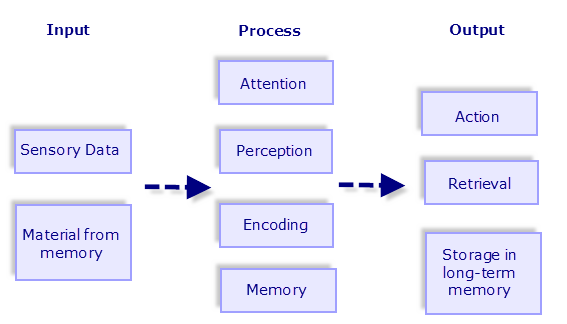According to cognitivism learning occurs within the individual mind as learners are assimilating new information to existing knowledge and making the appropriate modification to their existing intellectual framework to accommodate that information. Students play an active role in learning changing their minds, connecting prior ideas with new ones, thinking with what they learn and creatively applying knowledge in novel situations. In other words, learning occurs from the creation and recognition of students’ conceptual structures as a result of cognitive processing. This learning theory is based on Piaget’s work for developing increasingly abstract constructions of the world. (The two main representatives of trivial constructivism are Jean Piaget and Jerome Bruner, while Ernst von Glasersfeld makes a distinction between “radical constructivism” and “trivial constructivism” which fragmented the theoretical foundations of constructivist pedagogy).
Having as a metaphor for cognitive function the structure of a computer, the way that brain processes information could be described based on an information-processing, input-process-output model, which is used in the computer industry.
According to cognitivists, sensation, perception, attention, encoding and memory have an implication in learning process through which a learner develops effective ways of building schemata and processing information. The role of teachers is to design learning material that stimulates learners’ cognitive process and encourages learners to make mental connections. For example, teachers should consider the amount and type of information that they present and the speed at which it is presented to learners (sensation). Also, teachers should arouse perceptual interest with strongly defined material, present material in a structured form, review knowledge and assist learners to make relationships between old and new one, etc. (perception). Teachers should grasp learners’ attention, where the topic should be presented in an interesting way promoting active learning through exercises and activities (attention). Part of internal mental learning process is teachers to assist learners to organise material and making it meaningful for learning, for example by grouping items into “chunks” with less than ten items to be presented at one time (encoding). Teachers should encourage learners to use knowledge they already process providing visual and verbal representations (for example the role of memory in the design of a multimedia application). However, teachers should be aware that learners may need to make schemata explicit and challenge their own assumptions.
Cognitive Load Theory (CLT) makes a distinction between the nature of the learning task (intrinsic load), the format of instruction (extraneous load) and the development of cognitive schemata (germane load) (Schnotz & Kürschner, 2007). Intrinsic cognitive load is determined by students interaction with a specific learning environment and their ability to combine and build informational units together (Pollock, Chandler and Sweller, 2002) . The more complex the information is, the greater the intrinsic load is. The design, presentation and organisation of the learning material impose an extra mental effort on the learners’ working memory (extraneous load). The instructional design should aim to decrease extraneous load. The learners’ mental effort to process the new information and to integrate it into existing knowledge schemata cause an increase in learners’ working memory (germane load). The more engagement in the process of schema formation and automation is required, the higher germane load. All three types of load are additive and determine the total amount of cognitive load a learner is experiencing within a learning situation (Seufert, Jaenen & Bruenken, 2007).
For example, the design of a problem as a learning stimulus should include the following process:
- task analysis;
- problem generation based on the syllabus content;
- self-directed learning is promoted (sometimes one kind of collaboration is supported);
- the role of teacher as facilitator; and
- the assessment criteria in the context of the problem are presented clearly to students.
The process of self-directed learning and reflection are usually characterised by the influence course, where students attempt to identify, analyze, and solve the problems. Through intellectual activities learners are engaged to explore their experiences in order to generate new understanding and appreciations. Approaches to reflection integrating technology may involve reflective e-journals, blogs, e-portfolio and self-writing. Many teachers also use educational application based on problem-solving strategies including lateral thinking and trial and error method, and/or computer-based simulated situations.
Independent learning reduces the pace and pressure of teaching and increase the time spent on active and student-centred activities. Students can learn at their own pace and in a manner which fits them better. Many teachers present students multimedia applications and/or simulations and leave students to discover it. Students may formulate questions, manipulate the simulated environment, perform virtual experiments and observe the effects, etc.
The two above major categories self-directed (based on problem learning) and independent learning are inspired by cognitive constructivism and teachers can enhance their teaching by using new technologies promoting students’ learning. Overall, cognitivism is considered as a progressive step towards an approach that combines cognitive processes with the element of individual and shared meaning-making that is constructivism.
References
Jordan, A., Carlile, O. & Stack, A. (2008). Approaches to learning: A guide for teachers. New York: Open University Press.
Pollock, E. Chandler, P. and Sweller, J. (2002). Assimilating complex information, Learning and Instruction, 12(1), 61–86.
Schnotz, W. and Kürschner, K. (2007). A Reconsideration of Cognitive Load Theory. Educational Psychology Review, 19(4), 469–508.
Seufert, T., Jaenen, I. and Bruenken, R. (2007). The impact of intrinsic cognitive load on the effectiveness of graphical help for coherence formation. Computers and Human Behavior, 23(3), 1055–1071.

Cognitive Constructivism by Maria Limniou is licensed under a Creative Commons Attribution-NonCommercial-ShareAlike 3.0 Unported License.
